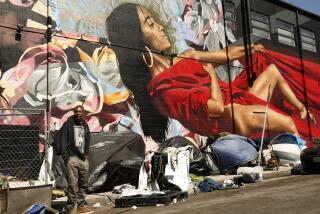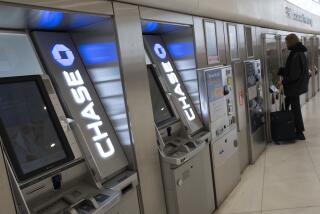Analysts Say Raise in Insurance Rates Would Be Passed On to Depositors : White House Puts New Wrap on Thrift Plan
- Share via
WASHINGTON — The Bush Administration, still struggling over options for financing the bailout of troubled savings institutions, sought Tuesday to resuscitate its plan to tax depositors--by repackaging it as an increase in the federal deposit insurance premium charged to S&Ls; and banks.
Administration officials said the proposal is among a series of options that will be sent to President Bush later this week, in time for him to make preliminary recommendations to include in his Feb. 9 budget revisions.
Analysts say increasing the federal insurance premiums would have essentially the same impact as a direct tax on depositors, because banks and S&Ls; almost certainly would pass on most or all of the cost to depositors through fees or lower interest on deposits.
However, it would presumably be more politically salable than the scheme for direct taxes on depositors, which has already been castigated by members of Congress. White House aides continue to back both proposals, but officials concede that the depositor-tax plan is crippled.
In addition, Administration officials said Tuesday that any Bush proposal to deal with troubled S&Ls; is also likely to contain a spate of new reform measures designed to reduce prospects that the current crisis might reemerge.
They said these include increasing the minimum amounts of capital that thrift institutions must maintain to back up their outstanding loans and toughening regulation by the Federal Home Loan Bank Board and other federal regulatory agencies.
The developments came as a divided Senate Banking Committee split sharply over whether to push for an immediate infusion of funds to shut down crippled S&Ls; or to opt for a longer-term package that includes tougher regulation and reform of the industry.
Sen. Alan Cranston (D-Calif.), calling for a prompt cash infusion, warned that Congress must act “as fast as we can to stop the hemorrhaging” or costs will escalate substantially and will push some S&Ls; “to the brink.”
But panel Chairman Donald W. Riegle Jr. (D-Mich.), supported by conservative Sen. Phil Gramm (R-Tex.), opted for a more comprehensive package that would include restructuring the troubled industry.
“Our only real lever to bring about fundamental changes is to do this as a package,” Riegle said. And Gramm warned the panel that without “pressure” from the financial crisis, Congress would not be able to enact regulatory reform.
Meanwhile, the Federal Home Loan Bank Board announced new regulations Tuesday that will sharply restrict the ability of insolvent S&Ls; to invest in so-called junk bonds--bonds that pay high interest rates but carry more risk than investment-grade bonds.
The agency, which regulates about 3,000 federally insured S&Ls;, said its new guidelines will prohibit insolvent S&Ls; from making new investments in junk bonds and will require them to sell their current holdings unless they are approved by bank board regulators.
Solvent but shaky institutions that do not meet capital requirements will be required to get government approval before buying junk bonds. Existing regulations permit the purchase of junk bonds, but institutions can invest no more than 5% of their portfolios in a single fund.
During the past several years, junk bonds have been a profitable investment for many S&Ls.; Analysts worry, however, that if the issuing companies default during an economic downturn, S&Ls; will be stuck for a loss.
The debate over the S&L; problem dominated comments by members of congressional banking committees Tuesday. House Banking Committee Chairman Henry B. Gonzalez (D-Tex.) said he strongly opposes any new charge on checking and savings accounts, whether imposed as a direct tax on deposits or as an increase in insurance premiums paid by institutions.
In Senate Banking Committee testimony, the panel heard a pessimistic review of the S&L; problem from Lowell L. Bryan, a director of McKinsey & Co., who predicted that it now would cost at least $100 billion to close or sell ailing savings and loan associations.
In similar testimony 15 months ago, Bryan had forecast that $100 billion was the maximum that would be needed to resolve the problem. “Now,” because of rising interest rates, “$100 billion is a minimum figure,” Bryan told the panel.
Increase in Premiums
Bryan’s figures substantially exceed the estimates of the Bush Administration, which figures that the total S&L; rescue effort will eventually cost only about $90 billion--some $40 billion of which has already been spent during bailout operations in 1987 and 1988.
The latest of the options that the Administration is considering would increase the premiums on federal deposit insurance paid by both S&Ls; and commercial banks. Banks now pay one-twelfth of 1% of their deposits, while S&Ls; pay about 2 1/2 times that rate.
However, some officials cautioned Tuesday that the plan to tax depositors directly still has not been formally rejected and that it will be considered by Bush with three or four other proposals being compiled by the Treasury.
There were some indications that the Administration may seek to combine portions of both proposals--that is, couple a much reduced direct fee on depositors with a small increase in the premiums charged to federally insured lending institutions.
Nevertheless, both Administration officials and congressional leaders say taxpayer money will probably wind up financing the bulk of the bill for the bailout, no matter which options Bush ultimately chooses.
That is how the financial community wants it. The S&L; and banking industries Tuesday reaffirmed their strong opposition to any increase in their insurance costs, whether through a tax levied on consumers or through a boost in the industry’s premiums.
Mary-Liz Meany, a spokeswoman for the American Bankers Assn., had no use for the increase in the insurance premium charged to financial institutions. “We think it’s the same idea just repackaged, and it’s a bad idea,” she said. “It’s still a consumer tax, once removed.”
Fred Webber, president of the U.S. League of Savings Institutions, agreed. The higher S&L; charge is already too onerous, he told reporters. “We just can’t afford it,” he said; “we would like to pay less.”
More to Read
Get the L.A. Times Politics newsletter
Deeply reported insights into legislation, politics and policy from Sacramento, Washington and beyond. In your inbox twice per week.
You may occasionally receive promotional content from the Los Angeles Times.







